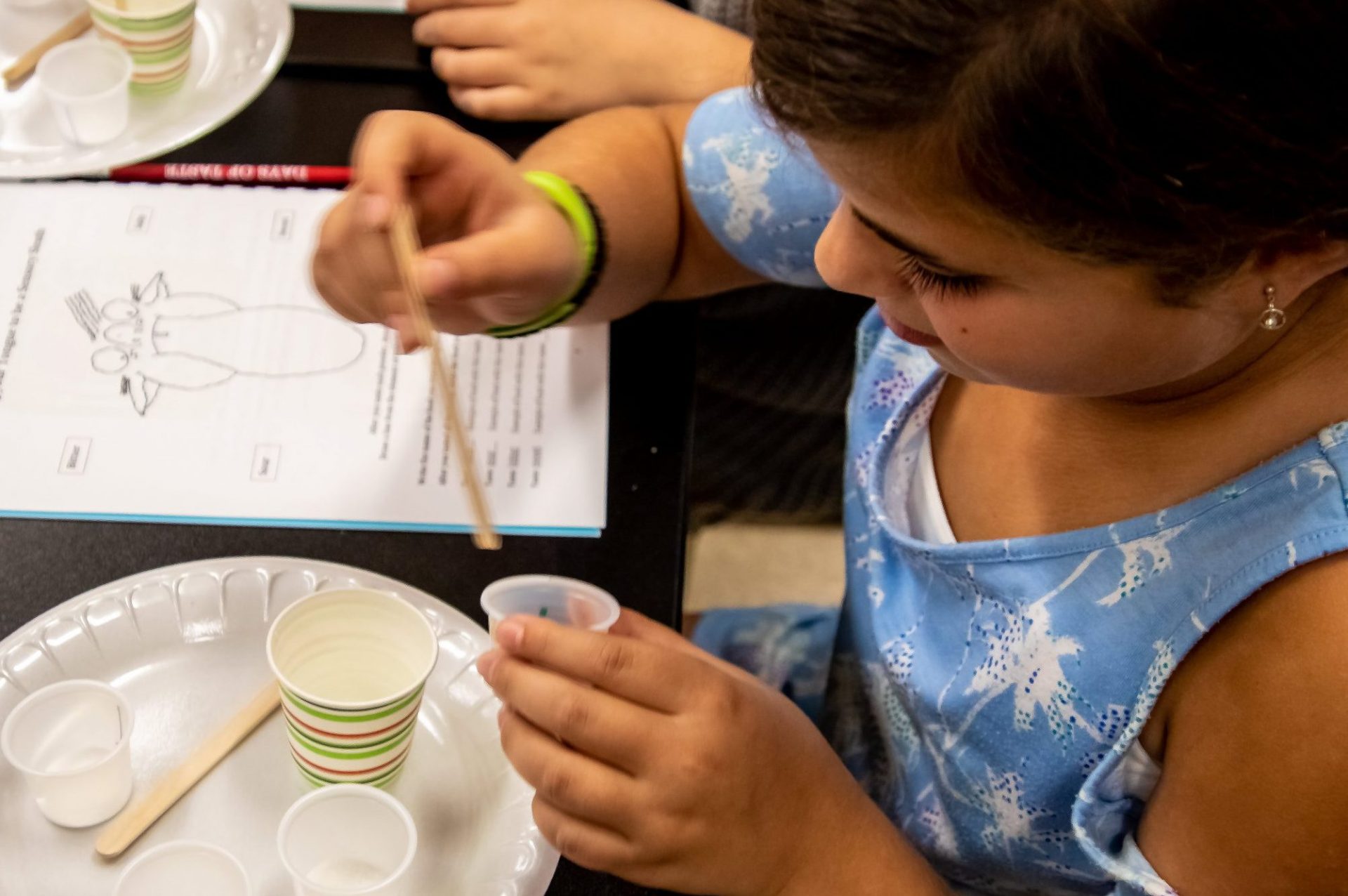#TWKatHome Activity: Becoming a Sensory Sleuth


Tuesday, April 21, 2020
Welcome back to #TWKatHome. We are excited to continue with our exploration of how food travels from farm to table and putting our tastes to work! This content is our way of sharing our Days of Taste program directly with you while at home. Check out our entire #TWKatHome series here.
TasteWise Kids – are you hungry for some learning?
Connect with Us
As you work through these activities jot down any questions about taste and balancing flavors you have. Our expert this week, partner Chef Chris Amendola (chef and owner of foraged. in Baltimore), is happy to answer your questions.
Share your questions for Chef Chris by sending us a message on Facebook (@TasteWiseKids) or Instagram (@tastewise_kids), or email info@tastewisekids.org.
This week’s theme: Taste Exploration
This week we are becoming Sensory Sleuths, or Taste Explorers. Think about when you take a bite of something new. What are the first things you notice? Do new foods you try have similar flavors to other things you like? Are you able to identify a food as sweet or sour before you decide if you like it?
To get started, let’s put on our food explorers’ hats. Think about the food you buy from the store to cook for dinner. How did it get there? Have you thought about how far some of your food might travel before it ends up on your plate?
Learn from an Expert: Chris Amendola of foraged. on Balancing Taste
Let’s start with the basics. What are your four tastes?
- Sweet
- Sour
- Bitter
- Salty
To learn a little more about each of our four tastes, watch Chef Chris Amendola, chef and owner of foraged. in Hampden in Baltimore City share a chef’s insight on taste using one of our favorite comfort foods – chocolate!
CocoaCompassion, the maker of the nibs Chef Chris forages for and features in this video and a partner of ours, isn’t just any chocolate company – they strive to start a conversation with every piece of chocolate they create, and are committed to reinvesting 20% of profit to provide underserved communities with high-value skills and resources. Give them a follow on Instagram to keep in touch!
There is also a fifth taste – umami (a meaty or earthy taste) that we are not going to focus on today but this PBS video explores umami if you want to check it out.
Let’s dig into the science behind taste for a moment so we can better understand how we are able to taste. Taste is detected by taste receptors (taste buds) on your tongue. Flavor is detected by olfactory (smell) receptors at the back of your mouth and in your nose. If you plug your nose, you can tell if a food is sweet, sour, salty or bitter, but you can’t tell the flavor of the food. Want to try a simple experiment to prove this? TasteWise Kids Executive Director Wendy Jeffries and her daughter recently demonstrated this in a Facebook Live Video.
Or here’s the experiment: Take 2 different color jelly beans (NOT cinnamon). Pinch your nose closed, and keeping your nose plugged, try the first jelly bean and guess the flavor. Then, keeping your nose plugged, try the second color. Do they taste different, can you taste the flavors, or are both just sweet? Now open your nose and try each jelly bean. Notice the difference?
Want to know why kids are often pickier eaters? While adults have over 10,000 taste buds (with between 50-150 taste receptor cells within each one) spread over our tongue that help us detect and distinguish different tastes, kids have about twice as many taste receptors!
What is also pretty amazing is that we can detect taste in less than 1/500 of a second! That’s almost twice as fast as we can feel anything and 10 times faster than we can see.
Activities: Becoming a Sensory Sleuth
Now it’s time to become a Sensory Sleuth – right in your kitchen. We are sharing 2 activities to try, feel free to try one or both!
Instructions are below or use this printable version: Becoming a Sensory Sleuth Activity
Activity 1: Identifying the 4 tastes
Materials for Activity
- 4 cups
- water
- about 1 tsp of each:
- sugar
- salt
- lemon or lime juice (if you don’t have these get creative – do you have grapefruit juice?)
- unsweetened coco powder (or cold brewed coffee can work too)
- cards/small pieces of paper with “salty”, “sour”, “sweet” and “bitter” (optional – helpful for younger learners)
Set Up
NOTE: The set-up is best done before kids are involved so they don’t know what is in each cup.
- Pour ¼ cup of water into each of the 4 cups
- Add 1 tsp of one ingredient into one cup
- Stir until mixed/dissolved (you may need to add a little extra of the coco powder to get the bitter flavor)
- Repeat with the other 3 liquids
Instructions
- Have your child taste one cup at a time.
- Ask him/her to identify which of the four tastes was represented
Debrief/Key Points from activity:
- While many kids will like sweet the best, there is no “right” or “wrong” answer to what they like most or least.
- To extend this activity, you can then have kids try to combine two of the liquids to make a more balanced “drink” – try adding a bit of the sugar water and the cocoa powder water together, etc.
Activity 2: Fridge Dive + Labeling similar tastes
Materials for Activity
- Small pieces of paper with “sweet”, “salty”, “sour”, and “bitter” written on them
- Pencil
- 5-10 food items in your kitchen (more is of course welcome)
Instructions
- Explore your fridge and cabinets for foods you think might be salty, sour, sweet and bitter. It helps if you pick simple,single ingredients (ex. Chocolate chips instead of a chocolate chip cookie or strawberry yogurt instead of a smoothie)
- Start with 5-6 food items. Lie them all out on the table.
- Taste one food item at a time. Try to identify which of the four basic tastes best represents this food item.
- Place the foods with similar tastes next to each other. Use a piece of paper to label each group. You do not need to have the same number of food items in each group – what’s important is that you are exploring your sense of taste.
- If you don’t have one taste represented, see if you can go back to find something of that taste. Or just brainstorm what might go in the group even if you don’t have it at home.
Debrief/Key Points from activity:
- It can be easier to identify tastes in some foods than others.
- The four tastes can be recognized in a variety of foods (not just spices, fruits, etc.).
- All flavors – and all foods – are made up of some combination of these tastes.
Don’t forget to share with us!
Have a question for Chef Chris about sweet, sour, bitter, or salty? Or about how chefs combine tastes to make amazing food? Send us your questions for Chef Chris on Facebook (@TasteWiseKids) or Instagram (@tastewise_kids), or email info@tastewisekids.org.
Also please share with us picture of what foods you used for your test taste Facebook (@TasteWiseKids) or Instagram (@tastewise_kids), tag us and use the hashtag #TWKatHome.
Want to keep learning?
- Want to help younger kids understand taste and how your tongue works? Check out this Taste-Maker video from SciShow Kids.
- Want to do more taste tests? Try this blind taste test from America’s Test Kitchen to understand the role of sight when you eat.
- Want to see more of Chef Chris Amendola in action? Check out this video of him sharing how to roast mushrooms.
- For older kids (and our adult kids), learn more about the fascinating science of taste video and this article about how all of our senses impact what we think tastes good.
Up Next
- #TWKFamilyFridays – Check the blog, Instagram and Facebook this Friday for 5 tips on how to use our tasting sheet when trying new foods with kids.
